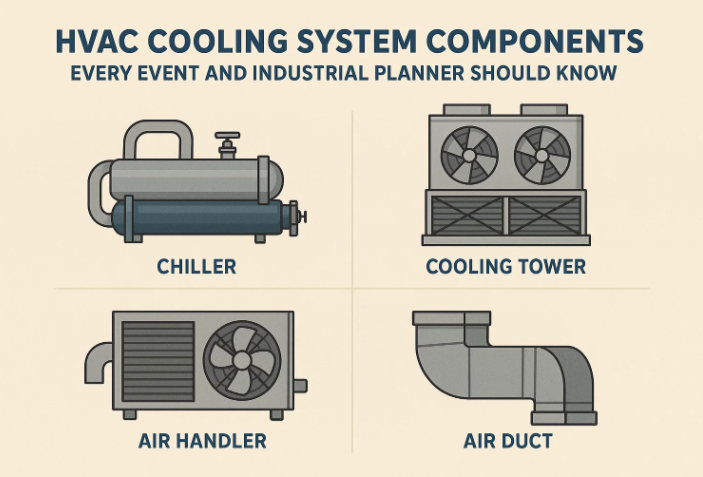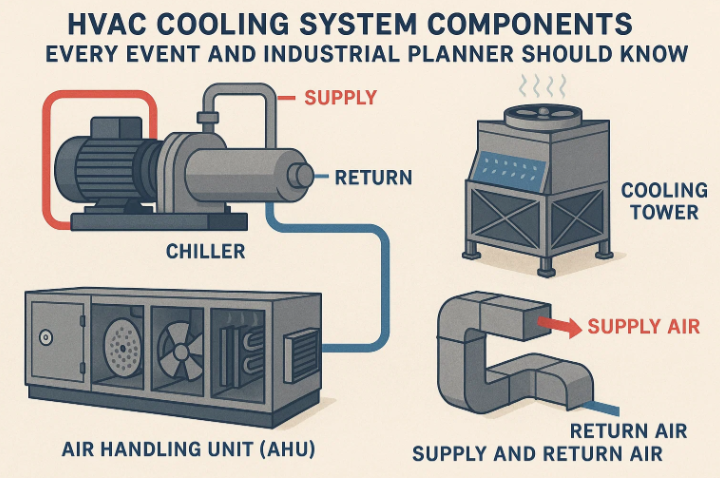HVAC Cooling System Components play a critical role in maintaining comfort, safety, and operational efficiency across event venues, industrial facilities, and large temporary structures. Whether you’re organizing a grand wedding in a dome tent, hosting a large-scale exhibition, or managing a warehouse operation, understanding how each part of an HVAC system functions helps you make better decisions about equipment, layout, and maintenance. A well-designed cooling system ensures consistent air temperature, stable humidity, and fresh airflow essential factors for both guest comfort and machinery performance.
From thermostats and evaporator coils to compressors and air ducts, every component contributes to the system’s overall effectiveness. For professionals in the event or industrial sector, gaining knowledge about these parts isn’t just technical; it’s practical for ensuring smooth, uninterrupted cooling during crucial operations.
HVAC Cooling System Components Every Event and Industrial Planner Should Know
In this guide, we will explain how each HVAC cooling system component works, why it matters, and what planners should know when selecting the right setup for their projects.
Whether you’re managing an exhibition, setting up a large wedding dome, or running a manufacturing workshop, one common challenge unites these environments — maintaining optimal temperature and air quality. Without a properly designed HVAC cooling system, even the most impressive venue can become uncomfortable, unsafe, or inefficient.
Understanding the components of an HVAC cooling system isn’t just a technical exercise. For event planners, it helps ensure guest comfort; for industrial managers, it’s about operational reliability. Knowing how each part works gives you better control over system selection, maintenance, and budgeting especially when choosing specialized systems like DrezAircon’s portable air conditioners built for tents, domes, and industrial environments.

What Is an HVAC System and How Does It Work?
HVAC stands for Heating, Ventilation, and Air Conditioning a complete system that controls indoor climate, air circulation, and air quality.
In simple terms:
- The air conditioner cools warm air through heat exchange.
- The heater or furnace warms air during colder seasons.
- Ventilation ducts and fans distribute this conditioned air evenly.
For large-scale events or temporary structures, portable HVAC cooling units replace traditional installations. These systems can deliver high air volume, quick installation, and flexible ducting to maintain comfort in spaces like wedding domes, exhibition tents, or warehouse operations.
Key Parts of HVAC Cooling Systems
Every cooling system relies on several mechanical and electrical components that work together to regulate temperature. Here’s a breakdown of the main HVAC cooling system components and their purpose.
1. Thermostat – The Control Hub
The thermostat is the control center of the entire system. It detects temperature changes and signals the cooling system to turn on or off as needed.
In event or industrial setups, programmable thermostats help maintain consistent temperature levels despite fluctuating occupancy or outdoor heat. For instance, during a 500-guest corporate gala, automatic temperature control ensures even cooling throughout the dome without manual adjustments.
2. Furnace – The Heat Source in HVAC Systems
Although the primary focus is cooling, the furnace plays a key role in systems designed for year-round use. It heats air before it’s circulated during colder months.
In portable event HVAC systems, this component is often integrated into packaged units to provide both heating and cooling functions when needed — making it ideal for all-weather event setups.
3. Heat Exchanger – The Energy Transfer Unit
The heat exchanger is responsible for transferring heat from the indoor air to the refrigerant (or vice versa).
In cooling mode, it absorbs heat from the air passing over the evaporator coil and expels it outdoors via the condenser coil. Efficient heat exchangers ensure the system operates with minimal energy loss essential for reducing power consumption during long events or industrial shifts.
4. Air Conditioning Unit – The Cooling Core
This is the heart of the system it cools air before distributing it indoors. The air conditioning unit includes components like the compressor, condenser coil, and evaporator coil.
In outdoor or large-scale applications, DrezAircon’s packaged air conditioners offer higher cooling capacities (ranging from 3 tons to 50 tons), built for high ambient temperatures up to 55°C. These units are ideal for tents, warehouses, or dome structures where fast installation and mobility are key.
5. Blower Motor – The Air Circulator
The blower motor pushes conditioned air through ducts and vents. A powerful motor ensures consistent airflow across wide areas.
For industrial setups with large open floors, high-capacity blowers ensure even temperature distribution and eliminate hot zones, maintaining comfort for workers and equipment stability.
6. Air Ducts and Vents – The Distribution Network
Ductwork acts as the transportation system for cooled or heated air.
In large event spaces or domes, flexible ducts are used for easy installation and directional airflow. Proper duct design ensures even cooling and reduces pressure loss.
Portable HVAC systems often use fabric or spiral ducts, which are lightweight yet durable a feature common in DrezAircon’s tent air-conditioning solutions.
7. Evaporator Coil – The Cooling Surface
The evaporator coil is where the actual cooling happens. It absorbs heat from the indoor air as the refrigerant evaporates inside the coil.
In DrezAircon’s portable AC systems, high-efficiency copper or aluminum coils are used to maximize heat transfer and ensure quick cooling even in high-density event spaces.
8. Condenser Coil – The Heat Releaser
The condenser coil releases the heat absorbed from the indoor air into the outdoor environment.
In industrial and outdoor event applications, condenser coils must withstand high ambient temperatures. DrezAircon units use reinforced condenser coils designed for tropical and desert climates, ensuring consistent operation under extreme heat.
9. Compressor – The System’s Engine
The compressor pumps refrigerant between the evaporator and condenser coils. It’s often called the “engine” of the HVAC cooling system.
Industrial-grade compressors provide steady pressure control, helping large systems maintain desired cooling levels during long-duration events or continuous factory operations. A failure in this component can halt the entire cooling process, making preventive maintenance essential.
READ ALSO: Best Air Dome Air Conditioner Service for Industrial and Temporary Structures
10. Expansion Valve – The Flow Regulator
The expansion valve controls the flow of refrigerant entering the evaporator coil.
Reducing refrigerant pressure allows efficient heat absorption. In precision environments like temperature-sensitive storage tents, accurate flow control ensures consistent performance and energy efficiency.
11. Electrical Elements – Power and Safety Components
Every HVAC system includes electrical control elements — relays, contactors, capacitors, and sensors. These components manage power flow, automate system cycles, and provide safety cutoffs in case of overloads or voltage issues.
Modern portable units, including those from DrezAircon, integrate smart control panels for quick diagnostics and remote monitoring during event operations.
12. Refrigerant – The Cooling Medium
The refrigerant is the chemical fluid that circulates through coils, absorbing and releasing heat as it changes states.
Eco-friendly refrigerants like R410A or R32 are now standard for energy-efficient, low-emission systems. For mobile event cooling systems, using non-toxic refrigerants ensures safety in densely populated spaces.
13. Fan – Airflow Management
Fans are responsible for pushing and pulling air through coils, ducts, and vents.
In portable air conditioners, axial or centrifugal fans provide high airflow rates to cover large open areas like wedding tents or exhibition halls. Noise reduction design ensures quiet operation, maintaining comfort for guests.

How to Take Care of Your HVAC System
Proper maintenance of your HVAC cooling system extends its lifespan, maintains energy efficiency, and ensures reliability during critical events.
Routine Maintenance Tips:
- Clean or Replace Air Filters Regularly – Clogged filters reduce airflow and strain the blower motor.
- Inspect Coils and Fins – Dirty coils reduce heat exchange efficiency.
- Check Refrigerant Levels – Low refrigerant can cause poor cooling or compressor failure.
- Inspect Ductwork for Leaks – Leaks reduce air pressure and cooling efficiency.
- Schedule Professional Servicing – Partner with trained technicians to prevent breakdowns before large events.
DrezAircon offers comprehensive air dome air conditioner services, ensuring your systems are event-ready, properly tuned, and energy efficient.
Common Issues and Solutions
| Problem | Possible Cause | Recommended Action |
|---|---|---|
| Uneven cooling in event space | Blocked ducts or poor airflow | Check duct design and blower fan capacity |
| Weak cooling | Dirty condenser or low refrigerant | Clean coils and recharge refrigerant |
| Excessive noise | Loose fan or worn bearings | Inspect fan assembly and tighten components |
| Unit not starting | Faulty thermostat or electrical control | Check wiring, relays, and thermostat settings |
Why Quality Components Matter for Events and Industry
Event cooling systems operate in demanding environments, fluctuating crowd sizes, open-air exposure, and variable weather conditions. Industrial systems face long working hours and dust-heavy atmospheres.
That’s why component quality directly impacts system reliability, energy consumption, and maintenance cost.
DrezAircon’s packaged air conditioning systems use durable compressors, corrosion-resistant coils, and smart airflow control to ensure uninterrupted cooling during critical operations, whether it’s a week-long exhibition or 24/7 industrial production.
Where to Buy or Rent High-Performance HVAC Systems
For event organisers or industrial managers seeking efficient, mobile, and reliable cooling solutions, DrezAircon offers a complete line of portable and packaged HVAC systems engineered for challenging environments.
Why Choose DrezAircon:
- Wide capacity range (3–50 tons)
- Suitable for tents, domes, and factories
- Designed for extreme climates (–20°C to +55°C)
- Fast setup and easy mobility
- Lifetime technical support and after-sales service
You can explore the full range of products directly at DrezAircon.com, request a custom quote, or consult the team for sizing recommendations.
Top 10 FAQs about HVAC Cooling System Components
1. What are the main components of an HVAC cooling system?
An HVAC cooling system typically includes a thermostat, evaporator coil, condenser coil, compressor, expansion valve, blower motor, ducts, and air filters.
2. What does the compressor do in an HVAC system?
The compressor circulates refrigerant between the evaporator and condenser coils, enabling heat transfer and cooling. It’s considered the “engine” of the system.
3. How does the evaporator coil work?
The evaporator coil absorbs heat from indoor air as the refrigerant evaporates, producing cool air that circulates throughout the space.
4. Why is the condenser coil important?
The condenser coil releases absorbed heat outdoors, completing the cooling cycle. Efficient condenser coils improve energy performance and system longevity.
5. What type of HVAC system is best for events or tents?
For temporary or large outdoor setups, DrezAircon’s portable and packaged air conditioners offer fast installation, high cooling capacity, and mobility.
6. How often should HVAC filters be cleaned or replaced?
Filters should be cleaned or replaced every 1–3 months, depending on use and environment. Clean filters improve airflow and prevent system strain.
7. What causes uneven cooling in large event spaces?
Uneven cooling may result from blocked ducts, undersized blowers, or poor duct design. Proper airflow management ensures consistent temperature.
8. Can HVAC systems handle extreme outdoor temperatures?
Yes. Industrial-grade systems, like DrezAircon units, are designed for wide ambient ranges — typically from –20°C to +55°C — ensuring reliable operation.
9. What is the role of the expansion valve?
The expansion valve controls the refrigerant flow into the evaporator coil, regulating pressure and enabling efficient heat absorption.
10. Where can I buy or rent reliable HVAC cooling systems?
You can explore high-performance, event-ready HVAC systems at DrezAircon.com, offering portable, industrial, and air dome units with expert service and support.
Conclusion: Build Comfort and Reliability Into Every Project
An HVAC cooling system is only as strong as its components. From thermostats to compressors, every part plays a critical role in maintaining comfort, safety, and efficiency.
For event planners and industrial managers, understanding these components isn’t about becoming an engineer; it’s about ensuring every project runs smoothly, no matter the temperature outside.
By choosing trusted partners like DrezAircon, you gain access to durable, energy-efficient, and portable cooling systems built to perform when it matters most.





